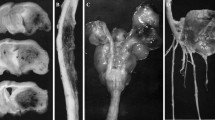Summary
The aim of this study was to produce large liver tumors reliably, and to diagnose the tumors during development. Therefore, New Zealand white rabbits were treated withN-nitrosodiethylamine orally three times per week by gavage and were examined by clinical-chemical assay at regular intervals during the average treatment period of 14 months. The total cumulative dose was 1200 mgN-nitrosodiethylamine over 14 months. After a short treatment period the initial dose of 3 mg/kg had to be reduced to 1.5 mg/kg. In all 11 treated animals (100%) liver tumors were seen at the end of the study. Four control animals did not show any neoplastic changes. Clinical parameters investigated were for an assessment of liver function, total protein, urea, creatinine, alanine aminotransferase, aspartate aminotransferase, alkaline phosphatase, albumin and neuraminic acid as well as some serum electrolytes. The in vivo diagnosis of liver tumors based on changes in these parameters proved to be relatively unreliable. The liver enzyme tests and urea concentration only yielded significant changes when the liver tumors were very large. Changes in neuraminic acid levels were the most reliable indicator for the presence of a liver tumor in this animal model. In the 11 treated animals, serum values of this marker increased towards the end of the study'by an average of 300 mg/dl. The induced tumors were mainly hepatocellular carcinomas. Only in 1 animal was a hepatocellular adenoma found. Further primary tumors diagnosed were six adenomas in the kidneys and two uterus adenomas, as well as nasal cavity tumors (two papillomas, one carcinoma, one adenoma and one adenocarcinoma). In 70% of the treated rabbits the hepatocellular carcinomas had metastasized to the lungs.
Similar content being viewed by others
References
Le Page RN, Christie GS (1969) Induction of liver tumours in the rabbit by feeding dimethylnitrosamine. Br J Cancer 23:125–131
Maki S, Konno T, Maeda H (1985) Image enhancement in computerized tomography for sensitive diagnosis of liver cancer and semiquantitation of tumor selective drug targeting with oily contrast medium. Cancer Res 56:751–757
Moore MD, Drinkwater NR, Miller EC, Miller JA, Pitot HC (1981) Quantitative analysis of the time-dependend development of glucose-6-phosphatase deficient foci in the livers of mice treated neonatally with diethylnitrosamine. Cancer Res 41:1585–1593
Nakakuma K, Tashiro S, Hiraoka T, Ogata K, Ootsuka K (1985) Hepatocellular carcinoma and metastatic cancer detected by iodized oil. J Radiol 154:No.l 15–17
Rapp HJ, Carleton JH, Crisler C, Nadel EM (1965) Induction of malignant tumors in the rabbit by oral administration of diethylnitrosamine. J Natl Cancer Inst 34:453–455
Reznik-Schüller HM (1983) Nitrosamine-induced nasal cavity carcinogenesis. Nasal tumors in animals and man. CRC press, Boca Raton, Fla., pp 47–77
Schmähl D, Osswald H (1967) Carcinogenesis in different animal species by diethylnitrosamine. Experientia 23:6
Seltzer SE, Adams DF, Davis MA, Hessel SJ, Havron A, Judy PF, Paskins-Hurlburt AJ, Hollenberg NK (1981) Hepatic contrast agents for computed tomography: high atomic number particulate material, J Comput Assist Tomogr 5:370–374
Vesselinowitch SD, Mihailowitch N (1982) Modifying effect of synthetic steroids on the development of liver tumors induced by diethylnitrosamine. Proc Am Assoc Cancer 73:91
Yumoto Y, Jinno K, Tokuyama K, Araki Y, Ishimitsu T, Maeda H, Konno T, Iwamoto S, Ohnishi K, Okuda K (1985) Hepatocellular carcinoma detected by iodized oil. J Radiol 154:19–24
Author information
Authors and Affiliations
Rights and permissions
About this article
Cite this article
Reznik, G.K., Padberg, G. Diethylnitrosamine-induced metastasizing hepatocellular carcinomas in New Zealand white rabbits. J Cancer Res Clin Oncol 117, 123–129 (1991). https://doi.org/10.1007/BF01613135
Received:
Accepted:
Issue Date:
DOI: https://doi.org/10.1007/BF01613135



